If you know me, you know that Twitter is like the social media equivalent of crack to me.
I could hang out on there all day.
(…And sometimes I do! Haha.)
Not only is it an awesome way to meet other writers and connect with like-minded solopreneurs – if you use it right, it can score some sweet freelance writing gigs.
In fact, I recently got a high-paying freelance blogging gig ($450+/mo) working for a super chill client – all because I used Twitter the right way.
If you want to see the exact process I used to land that client, I’ve got a case study you can download right here:
(AW SNAP – snag that!)
Now, I want to go over everything I’ve done to get freelance writing work from Twitter.
But before we move forward, I want you to know something:
This marketing strategy, like so many of the others I recommend, relies heavily on you knowing your niche + target client.
(If you’re freaking out right now because you don’t know what your freelance writing niche is, I’ve got you covered – read this blog post on how to pick a niche!)
Okay, now that we’ve got that out of the way, let’s start with the basics.
Set up your profile the right way.
Let’s face it – if you’ve got an egg for a profile picture and your favorite Marilyn Monroe quote as your bio, you aren’t going to be landing freelance clients on Twitter anytime soon.
Clients want to know that you can be trusted, that you’re a good writer, and that you have the industry expertise necessary to get the job done right.
With that in mind, here’s what you need to include in your profile:
- A picture of yourself.
Putting a real picture of yourself in your profile picture helps build trust with clients.
On top of that, using the same picture for all of your social media profiles and bylined blog posts makes you more memorable and help you build a stronger online presence!
Here’s the profile picture I use for Twitter:
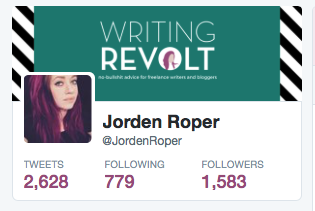
Now, let me tell you a little secret about this picture…
It’s actually a selfie that I took in front of a black shower curtain. (#Classy)
And I use it on all my bylined blog posts and social media accounts!
So, don’t get too caught up thinking that you MUST have a stuffy, business-y picture of yourself to attract clients.
Just post a recognizable picture of your face, and use that same picture anywhere someone might find you online. Trust me – this is super important when you’re trying to build a personal brand online!
- Key words related to what you do.
Obviously, you’re a freelance writer.
So you want “freelance writer” in your bio somewhere so clients can find you.
But don’t stop there. Put your niche in your bio too, like this:
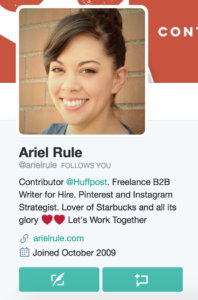
See how Ariel has “B2B” there?
It’s SO smart, because it means that people who are looking specifically for a B2B writer will be able to find Ariel when they search for a B2B writer on Twitter.
When I started out, I’m pretty sure my bio said something like “Freelance B2B and Technology Copywriter.”
Not only did those specific key words make it easier for my target clients to find me – it helped those clients who landed on my profile immediately recognize me as a niche expert.
If you want to win over local clients, you can also put the name of your city in your bio, like this:
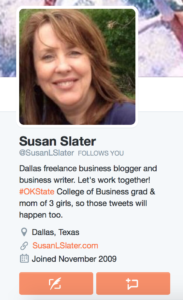
Because Susan has “Dallas” right in her bio, she pops up in the top Twitter search results for “Dallas freelance writer.”
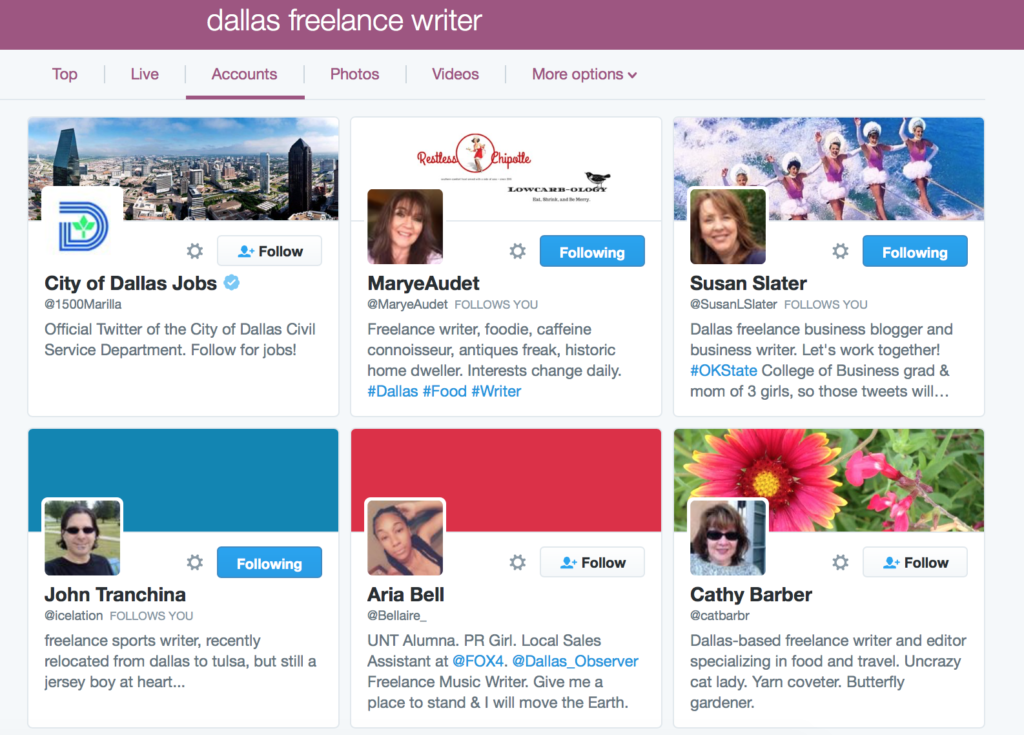
So, there’s a good chance that clients who are using Twitter to find a local Dallas writer are going to come across her profile.
Freaking. Genius.
Bottom line:
You have to think of Twitter as a search engine your potential clients are using to find writers.
Use words in your bio that your target clients will use when they’re looking for a writer like you.
And pick a username that’s professional and relevant too.
Just like with your picture, it doesn’t necessarily need to be stuffy/corporate-y – it just needs to make sense from a business standpoint.
Basically, if you use “@Babygirl208” or “@RebelDude69,” you’re prooooobably not going to be taken seriously by potential clients. 🙂
Consider sticking with your name or the name of your freelance writing business.
- A link to your freelance writer website.
You need a freelance writer website that clearly states your niche if you want to consistently land high-paying clients and set yourself up for long-term success.
And when you have that website, you need to share the shit out of it.
One of the places you need to post the link?
Your Twitter bio.
When people open the link to your site, they should recognize your niche expertise right away.
For example, if you say that you’re a “Tech Freelance Writer” in your Twitter bio, your website should clearly state that you’re a “Tech Freelance Writer” too.
Seriously – don’t be shy about it. Slap that shit up at the top of your site – preferably in your main headline.
That way, everyone who clicks over to your site immediately recognizes your niche expertise.
…And that means they’ll be more likely to hire you / pay you the big bucks. YASSSS.
Start following and interacting with your target clients.
Now that you’ve got your profile set up, it’s time to start putting yourself in front of your target clients.
Now, don’t just look up random businesses and start stalking them.
Really be strategic here, and look up your target clients based on your specific niche.
For example, when I first started freelance writing, my niche was writing IT/tech content.
So, I looked up IT service providers on Twitter, like this:
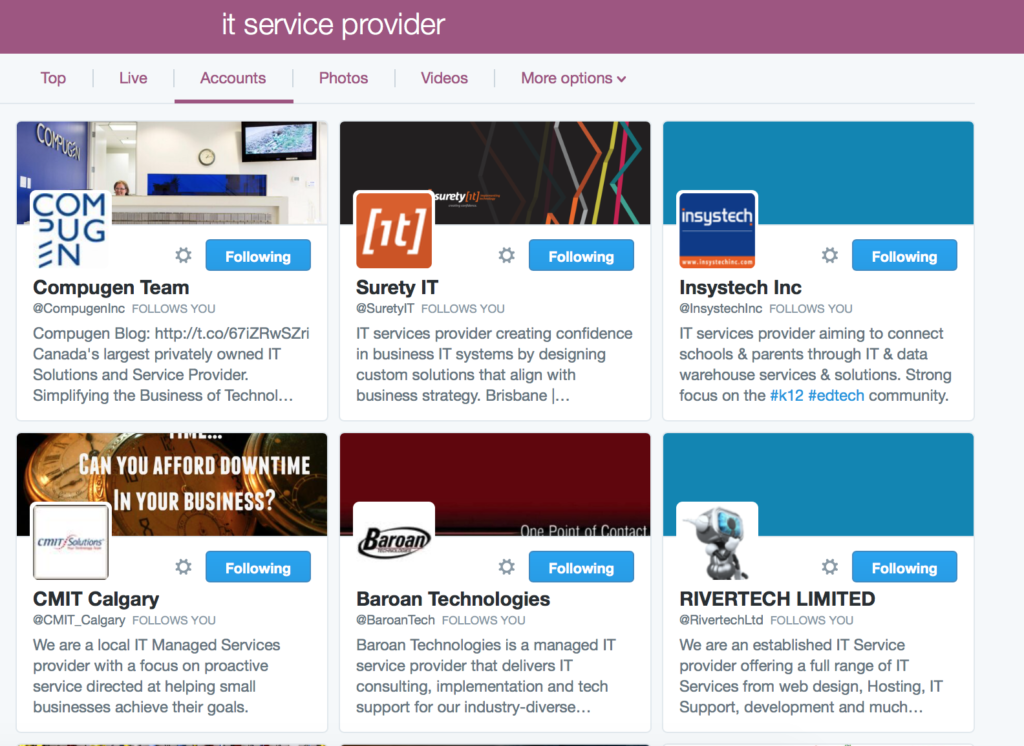
Then, I’d just go through and follow them. Sometimes, I’d look through their Tweets and “like” a couple of them.
I’d also respond to their Tweets if I had something to add.
Now, you might be thinking:
Um, that sounds time-consuming and pointless. Why bother?
The short answer:
Because it can put you on your target clients’ radar.
Many of them will end up checking out your profile if you interact enough.
And when they visit your profile, they’ll see your niche and recognize your expertise. They might follow you back too (lots of the IT service providers I followed when I started out followed me back!).
Then, you’ll stay on their radar as a niche expert, and they’ll be more likely to hire you when they need writing help.
So, start building relationships.
Like your target clients’ posts sometimes. Respond to their Tweets. Just be a human being and interact in a genuine way.
AFTER you build a relationship with a target client, it’s totally cool to pitch them or let them know that you’re there to help if they need a writer (which we’ll talk about more in-depth later in this post!).
Consistently share content that’s relevant to your audience.
Again, when I say “your audience” here, I’m not just talking about “businesses.”
I’m talking about the SPECIFIC type of business you write for.
For example, when I started out, I shared content that was super relevant to my audience of IT service providers and B2B/tech companies.
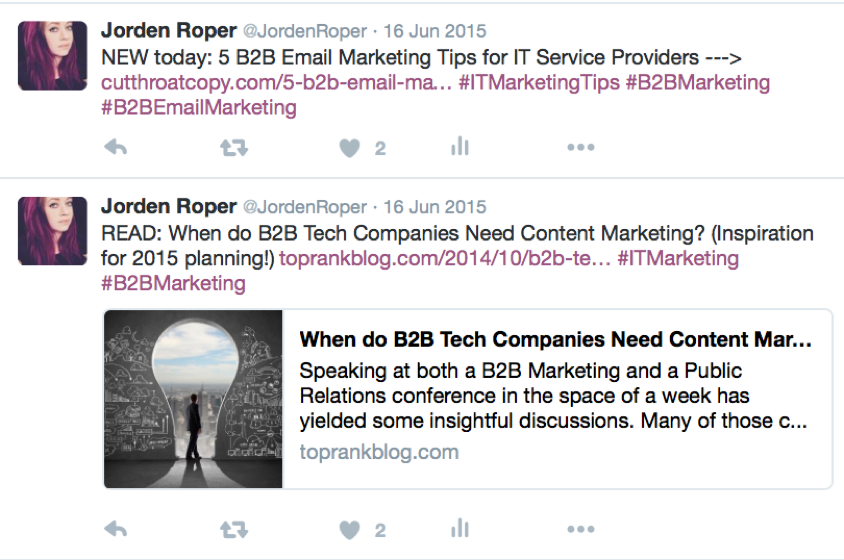
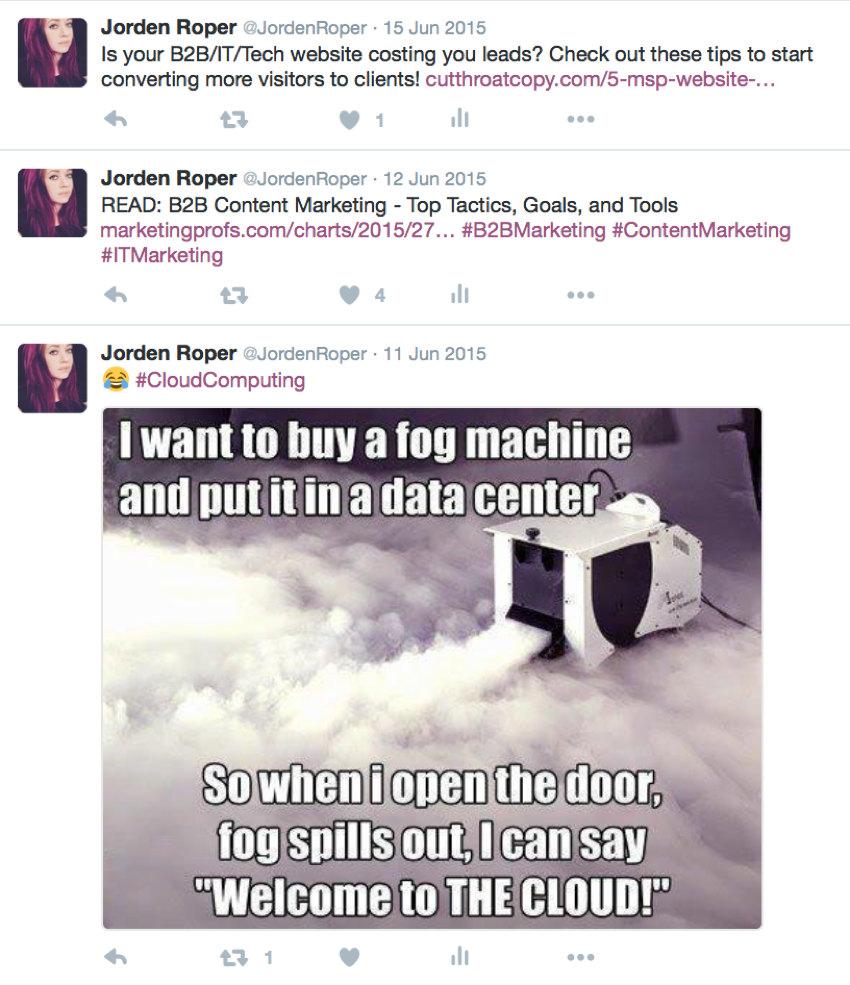
Doing this allowed me to attract my target clients and position myself as a good writer for them.
From the second they looked at my profile and Tweets, they could see that I had industry expertise.
Let’s look at another example.
I follow a writer on Twitter who I’ve noticed specializes in writing dental content.
He focuses heavily on sharing content relevant to dentists, like this:

And you can see that this bio is filled out specifically to attract his target clients.
He even uses “@dentalwriters” as his Twitter handle!
It’s easy to understand how his approach positions him as dental content expert to his target clients.
You don’t have to guess his area of expertise – it’s apparent from the SECOND you visit his profile.
So, make sure you’re positioning yourself as an expert on Twitter by sharing content that’s relevant to your target clients.
You want them to look at your profile and say:
HELL to the YES. This writer has the EXACT industry expertise to help me with what I need!
Hashtag it up!
Hashtags are important because they help your target clients find you on Twitter.
To make this a little more clear, let me show you another screenshot from my days specializing in IT/B2B/tech content.

If you aren’t familiar with the term “MSP,” it means managed service provider (kind of another term for “IT service provider”).
That’s the kind of company I was trying to attract, which is why I included hashtags like “#MSP” and “#MSPMarketing.”
Now, you’ll have to research a bit to figure out which hashtags are best for you to use – it really depends on what’s most relevant to your niche and target clients.
For example, if you specialize in healthcare marketing and want to share a blog post you’ve written about that topic, you might use “#healthcaremarketing” as a hashtag in your Tweet.
When you’re choosing some hashtags to use, remember:
You don’t necessarily need to use popular hashtags to get a target client’s attention. It’s much more important to use hashtags that are relevant to that specific target client!
So go ahead – make a list of Twitter hashtag ideas, and start experimenting to see which ones drive the most engagement from your target clients.
Reach out to people after you’ve interacted with them.
Don’t worry – you don’t have to spend months responding to every single Tweet someone creates.
Just make sure you do it enough to get on their radar.
Then, you can send a simple message asking if they need writing help.
You don’t have to send a hard pitch here – you can totally keep it casual. Just let them know what you do and ask them if they work with freelance writers!
Here’s an example of how I did it:
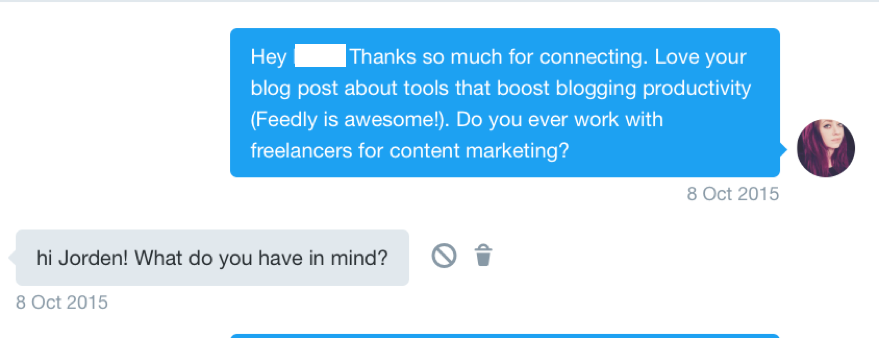
You can see that I wasn’t overly sales-y here.
I took the time to interact with his Tweets for a while. Then, I checked out his blog and gave him genuine feedback on it – I knew that’d be a great way to make a personal connection before I asked if he hired freelance writers!
And you know what?
It worked.
I wrote for him for several months, and it was a great experience.
So, don’t be afraid to reach out to people in a friendly way after you’ve interacted with them. You never know – your next big freelance writing opportunity might be one Twitter DM away!
Follow Twitter accounts that share freelance writing jobs.
If you’re a regular reader here, you know that I don’t normally encourage writers to use job boards.
But you know what?
I know that it takes time to see results from your marketing efforts.
And I understand that, if you need money to pay your rent next week or something, a job board might be an option you need to consider.
The key is to avoid low-quality job boards.
And don’t keep using job boards just so you can avoid marketing yourself.
Sure, job boards can be great for landing a quick gig, but you need to master marketing to set yourself up for long-term success.
So basically, before you keep reading this section, I want you to promise me that you’ll prioritize marketing yourself. Don’t get stuck using job boards forever!
*steps off soap box*
🙂
Okay – now that my little rant is out of the way, lets look at a couple Twitter accounts that share freelance writing jobs.
Here’s my favorite:

Darren shares a lot of awesome content related to blogging/writing. But he also shares job ads from his ProBlogger Job Board, like this:

(I’ve landed some pretty amazing freelance blogging gigs using the ProBlogger Job Board, so it’s the main board I recommend to newbie freelance writers!)
Here’s another one:

This account regularly shares gigs. And they publish a list of new freelance writing jobs on their website every weekday.
A bonus tip?
After you apply for these gigs, reach out to the person who posted the gig and make a connection.
I used to do this all the time when I applied for jobs on the ProBlogger Job Board.

Doing this a great way to make yourself stand out – and standing out is critical when you’re competing against dozens (or even hundreds!) of other writers for a high-paying gig.
Again, I really want to make it clear that you should not rely on job boards alone to land freelance writing jobs.
Yes, these can be good options if you really need to make some quick cash. And they can certainly be better than bullshit sites like UpWork.
But if you’re already making a livable income, you should be focusing on actively marketing yourself – not applying for gigs on job boards.
Land the gig when someone calls for writing help.
Hang out on Twitter enough, and you’ll probably notice occasional calls for writers.
A business owner will Tweet asking for writing help or asking their following to recommend a solid writer.
That’s where you need to step in and make yourself irresistible to them.
Sound impossible?
It’s not. In fact, I used this exact strategy recently to land an awesome, high-paying freelance blogging client.
That’s right – a simple series of Tweets allowed me to land a gig.
Want to see exactly how I did it?
Click this banner to read my case study and learn exactly how I landed a high-paying freelance blogging client on Twitter (it’s FREE!):
And if you have any questions about finding freelance writing clients on Twitter, feel free to ask away in the comments section below! I’ll do my best to help. 🙂


